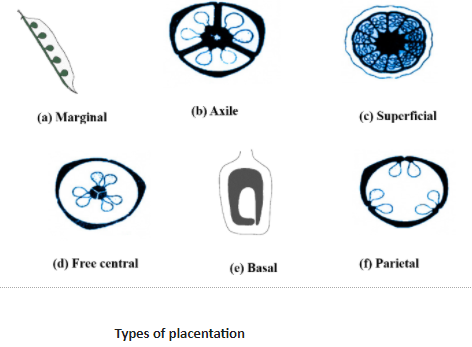
Free-central placentation is seen in
(a)Brassica
(b)Citrus
(c)Dianthus
(d)Argemone
Answer
481.5k+ views
Hint: A flower belonging to the family Caryophyllaceae with the flowers having five petals, typically with a frilled or pinked margin. It is observed in Primrose.
Complete answer:
In plants, placentation is the attachment of ovules inside the ovary of the flower. The part of the ovary where the ovule is attached is referred to as the placenta hence the arrangement is referred to as placentation. In free central placentation, a unilocular ovary is seen and ovules are arranged on the central axis. This is seen in the dianthus.
Additional Information: -The term placentation means the formation, arrangement, and structure, of the placenta of an organism along with its type.
-The nutrients, water, and respiratory gases as well as the removal of excretory wastes are exchanged and moved between the body of the mother and fetus is done by placental tissues.
-Placentation types in flowering plants include:
Basal: The placenta is found in all syncarpous ovaries. In this single ovule is attached at the base (bottom) of the ovary. E.g.: Sunflower
Parietal: It is found in a multicarpellary syncarpous ovary. Unilocular ovary becomes bilocular and ovules attach to the margin .E.g.: Cucumber, Argemone
Axile: It is also found in a multicarpellary syncarpous ovary. The ovules are arranged on the axis like the placenta. E.g.: Citrus fruits, Brassica
Free central: It is found in a syncarpous ovary. The unilocular condition of the ovary is formed and ovules are arranged on the central axis. E.g.: Dianthus, primroses
Marginal: It is found in the monocarpellary unilocular ovary, the placenta forms a rigid along ventral side, and ovules are arranged in two vertical rows. E.g.: pea
So, the correct answer is ‘Dianthus’.

Note: The name Dianthus is derived from the Greek words Dios ("of Zeus") and anthos ("flower"), and was cited by the Greek botanist Theophrastus. The placentation occurs mostly in syncarpous ovaries, where carpels have fused and appeared as one carpel, but when you cut it open you can see there is more than one ovary.
Complete answer:
In plants, placentation is the attachment of ovules inside the ovary of the flower. The part of the ovary where the ovule is attached is referred to as the placenta hence the arrangement is referred to as placentation. In free central placentation, a unilocular ovary is seen and ovules are arranged on the central axis. This is seen in the dianthus.
Additional Information: -The term placentation means the formation, arrangement, and structure, of the placenta of an organism along with its type.
-The nutrients, water, and respiratory gases as well as the removal of excretory wastes are exchanged and moved between the body of the mother and fetus is done by placental tissues.
-Placentation types in flowering plants include:
Basal: The placenta is found in all syncarpous ovaries. In this single ovule is attached at the base (bottom) of the ovary. E.g.: Sunflower
Parietal: It is found in a multicarpellary syncarpous ovary. Unilocular ovary becomes bilocular and ovules attach to the margin .E.g.: Cucumber, Argemone
Axile: It is also found in a multicarpellary syncarpous ovary. The ovules are arranged on the axis like the placenta. E.g.: Citrus fruits, Brassica
Free central: It is found in a syncarpous ovary. The unilocular condition of the ovary is formed and ovules are arranged on the central axis. E.g.: Dianthus, primroses
Marginal: It is found in the monocarpellary unilocular ovary, the placenta forms a rigid along ventral side, and ovules are arranged in two vertical rows. E.g.: pea
So, the correct answer is ‘Dianthus’.

Note: The name Dianthus is derived from the Greek words Dios ("of Zeus") and anthos ("flower"), and was cited by the Greek botanist Theophrastus. The placentation occurs mostly in syncarpous ovaries, where carpels have fused and appeared as one carpel, but when you cut it open you can see there is more than one ovary.
Recently Updated Pages
Glucose when reduced with HI and red Phosphorus gives class 11 chemistry CBSE

The highest possible oxidation states of Uranium and class 11 chemistry CBSE

Find the value of x if the mode of the following data class 11 maths CBSE

Which of the following can be used in the Friedel Crafts class 11 chemistry CBSE

A sphere of mass 40 kg is attracted by a second sphere class 11 physics CBSE

Statement I Reactivity of aluminium decreases when class 11 chemistry CBSE

Trending doubts
10 examples of friction in our daily life

One Metric ton is equal to kg A 10000 B 1000 C 100 class 11 physics CBSE

Difference Between Prokaryotic Cells and Eukaryotic Cells

State and prove Bernoullis theorem class 11 physics CBSE

What organs are located on the left side of your body class 11 biology CBSE

How many valence electrons does nitrogen have class 11 chemistry CBSE




